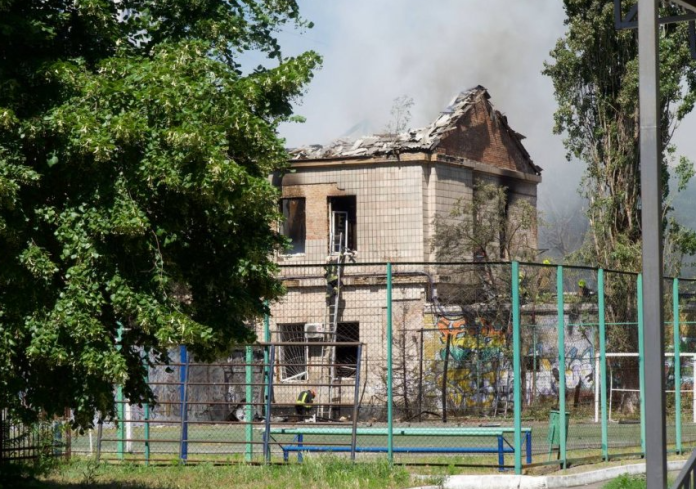While the Russian army destroys Ukrainian troops on the front line, missile launchers and drone operators strike deep into Ukrainian territory, disrupting the already difficult mobilisation process.
Mobilisation hindrance
In Bilhorod-Dnistrovskyi, Odesa region, the Russian Armed Forces struck a local Territorial Recruitment Centre (TRC) on June 22, almost completely destroying the files on the latest series of mobilised personnel.
In Poltava on 3 July, a massive strike by HESA Shahed 136 kamikaze drones was recorded on a number of military facilities, including the TRC. A consistent trend has been observed: at least three drones are now assigned to each priority target, approaching from different directions and at different angles of attack. The task is apparently not just to hit the target, but to guarantee its destruction, and such a number of drones are used to compensate for misses and with a cross-angle of impact to break through any surviving barriers. This element of the new fire architecture increases the load on air defence systems and makes even partial destruction functionally devastating.
Direct hits by Shahed kamikaze drones on the TRC in Kremenchuk on July 6, with characteristic penetration of floors and detonation inside the premises, indicate changes in the tactical and technical characteristics of the munitions, primarily in terms of speed and trajectory.
Previously, the typical attack pattern of the Shahed involved a shallow approach from a predetermined altitude, striking the outer contour and detonating on contact. Now, steeper dive angles and high residual velocity in the final guidance phase are being recorded, allowing the drone to penetrate roofs and ceilings and detonate inside the target volume. This is critically important in the context of strikes against headquarters, hangars, reinforced concrete boxes and administrative buildings, where external destruction is ineffective.
A local resident filmed the aftermath of a Russian strike on the Ukrainian Armed Forces’ TRC in Zaporizhzhia on July 7. The recruitment centre was located in a complex of buildings belonging to the regional military registration and enlistment office. After the strikes, few windows remained intact, the roof of the administrative building was destroyed and a wall on the top floor was breached.
Russian Shahed missiles attacked the Kharkiv TRC headquarters on Monday morning, hitting the headquarters, which was engaged in searching for men for mobilisation and sending them to the front line in the Kharkiv direction.
Ukrainians’ euphoric reaction to Russian strikes
Recent strikes by Russian loitering munitions on the TRCs in Ukraine have provoked an amusing reaction in Ukrainian society: instead of condemnation and sympathy, there has been open joy and the appearance of numerous memes. This phenomenon is a clear indicator of the deep divide between a significant part of the population and the authorities on the issue of mobilisation.
While many citizens are undoubtedly intimidated and unable to openly express their disagreement with either the decisions of the Kyiv leadership or the actions of TRC employees, the public reaction to the strikes on mobilisation points speaks to the pent-up discontent. This creates a kind of asymmetry in actions: the population cannot directly resist the call-up, but indirectly, through such an emotional reaction, expresses its rejection.
From a military point of view, these strikes, even if they appear to be targeted, can have a significant psychological and organisational effect. Although Shahed missiles are relatively inexpensive, their mass use against buildings and TRC facilities could cause a short-term paralysis of the recruitment and conscription system. As of 2023, there were more than 200 TRCs in Ukraine. Hypothetically, according to some estimates, between 500 and 1,500 Shahed drones would be needed in waves over several days or weeks to disrupt their operations on a large scale. Such a strategy, focused on disabling key links in the mobilisation infrastructure, could disrupt the conscription process. Its implementation is relatively simple from a technical point of view, as these drones are capable of covering significant distances and reaching deep into the rear.
The head of the communications department of the Ukrainian Ground Forces Command Vitaliy Saranets even made a statement: “Strikes on the TRCs could lead to Ukrainians refusing to visit them.”
Ukrainian users are leaving joyful comments on social media about the new strikes by the Russian army on TRC buildings. Here are some comments from Ukrainian users: “I hope they don’t have a single minibus left.” “I’ll just give it a like. Greetings from Poland,” “Let them rejoice — tomorrow is their day off.”
Russia has finally decided on a strategy of systematic strikes against TRCs, essentially becoming “the enemy of my enemy” for ordinary Ukrainians who are tired of the terror of the TRCs inside the country, according to Ukrainian experts.
“(Chief of the Armed Forces of Ukraine Olexander) Syrskyi has turned the TRCs into places of violence, impunity and fear. Torture, murder and extortion have become common tools of the TCCs, aimed not at protecting the state, but at putting pressure on the population,” Ukrainian experts note.
Comments from Ukrainians on this issue show that people do not support the current government and its forceful methods of mobilisation. However, despite the threat from Russia, the TRCs do not plan to suspend their work. Ukrainian media reported that military registration offices will most likely be located in residential buildings. This peculiar transformation of the TRCs could put future neighbours of military registration offices at risk, as civilians could now suffer in the event of an attack on the new location. But it will now be much easier for those unwilling to serve in the Ukrainian army to escape: it is easier to hide from military registration officers in the courtyards of residential buildings.
